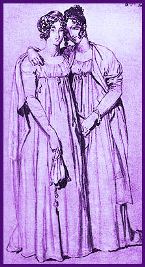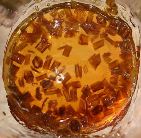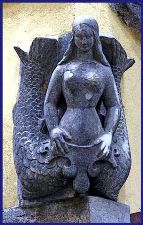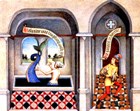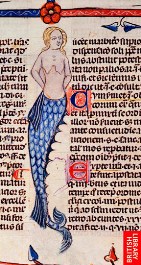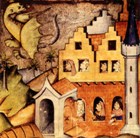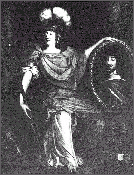Angélique - Marquise of the Angels
This is the book that introduces us to the epic 'oeuvre' that Anne Golon is so determined to preserve, rectify and complete for our pleasure and to satisfy our 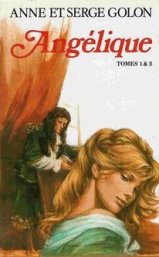 cravings for a conclusion. In my personal view, it stands to reason that there must be something special about this book, published in 1956, to continue to arouse our curiosity in 2018. The question then, is, what is it? And why, as we are already proven devotees, does Anne Golon need to change a thing?
cravings for a conclusion. In my personal view, it stands to reason that there must be something special about this book, published in 1956, to continue to arouse our curiosity in 2018. The question then, is, what is it? And why, as we are already proven devotees, does Anne Golon need to change a thing?
If the truth be told, we all fell under the spell of Anne Golon's eponymous heroine in whatever language we first met her. In my case it was in English, although since that time I have read the final three books in French and the entire series, including the concluding three books in Polish.
I think that the two subjects I have chosen to expand on in this section, the Angelica plant and the history of Mélusine, must be the outstanding subjects and images that held me in thrall at the start of the book which then led to a total captivation of the subject matter and the characters involved.
In the books great favour, to even get me to pick it up in the first place, was the fact that it was not set in Napoleonic France (a 'nation of shopkeepers indeed!'). My sister is obsessed with this period and as she still had a heavy influence on my reading tastes at the time, I could well have followed suit - but there was just something not right about those 'empire lines' and 'kiss curls' as far as I was concerned. I am an artist by profession and am very aware of images and imagery and the Empire just does not do it for me! (Having said that - I really am about to drop myself in it here - William Makepeace Thackeray's Vanity Fair is one of my all time favourite books!)
I truly believe that those fans/readers who first met Angélique in the English language and became enthralled in her life felt a certain bereavement at the end of Angélique and the Ghosts which was the last book to be translated into English. The bereavement probably came from the fact that the book was clearly meant to lead onto another in the series or was, for one reason or another left unfinished.
In the late 1980s / early 1990s, before the advent of the Internet and instant access to Search Engines, the English reading public knew very little about the author(s). To all intents and purposes, we may well have believed that the author(s) had 'disparu' (disappeared as quoted on some of the J'ai Lu books with reference to Serge) considering the time which had elapsed between the publishing dates, first of all between 'Angélique In Love' and 'Countess Angélique'; then 'Temptation' and 'Demon' and finally the very long wait between 'Demon' and 'Ghosts'.
Returning to the question of why I refer to the authors as author(s) in this manner? In all of Europe and elsewhere outside of the United States, the UK and Australia, it was public knowledge that the author known as 'Sergeanne' Golon, in the English-speaking world, was the husband and wife team of Anne and Serge Golon who were the co-producers of this series. Anne wrote and Serge researched - a marriage, in more ways than one, made in heaven.
In the English speaking world no-one knew the gender of 'Sergeanne' and when it was revealed that these were two individual people, for some (still unexplained to this day) reason, it was 'assumed' that they were brother and sister. Not until the advent of the Internet were we privileged to find out the true identities of the author(s), that Serge was indeed deceased and that there were three books written after his death, by Anne as a solo artist, that had never been translated into English.
Today, these must rank as three of the most famous titles in the English-speaking world that have never been made available to a global English-reading public: 'Angélique à Québec', 'Angélique - La Route de L'Espoir' and 'La Victoire d'Angélique' - and the fourth 'Angélique et le Royaume de France' the most famous not yet completed!
As to my second question - why does Anne feel the need to change anything. Anne believes that there is a need to accomplish this because her original manuscripts have been edited, in some cases, beyond recognition making some of the content confusing and illogical. Even with the restoration of the original, in hindsight, she feels that as the saga has continued well beyond her own expectations, she needs to revisit some of the earlier content and improve it with some additional information that would add a greater cohesion to some of the linked events. This version she calls her Intégrale.
The Angelica Plant
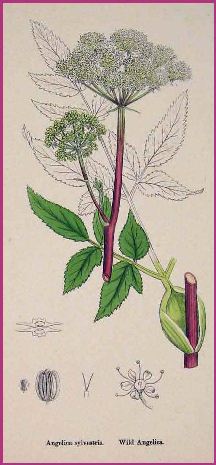
Just a few weeks ago I spotted an article in the Daily Mail referring to Monty's Plant of the Week - 'Purple Angelica' (Angelica Gigas) and nearly dropped the paper, looked at the date to make sure it wasn't April 1st, as I had never heard of a purple variety before. As purple is one of my favourite colours, it could have been someone having a joke with me. What was very strange was that when I tried to find the article on an on-line version of the paper, I found that the section had been 'whited out' with a message concerning copyright issues (the conspiracy theorists would have a field day with this!).

Luckily I had kept the original and you can see a full scan of the article here. I had a look and there are many images of the purple version on the internet some of which I couldn't resist sharing with you on this page. (The same article re-appeared in 2018)
I think what people also find fascinating is the fact of 'candied' angelica - eating something sweet and delicious which is green as that colour is usually associated with the bitter or tangy taste of lime!
How to crystallize Angelica
 1/2kg (1lb) angelica stems.
1/2kg (1lb) angelica stems.
Wash the stems and cut into 8-15cm (3-6in) lengths. Boil them in enough water to cover until the stems are tender. For young stems this should only take about 10 minutes. Drain well, rinse with cold water and drain again. Scrape the outer skin from each piece. I found it easiest to slit down the side of each hollow tub and lay them flat on the surface. The skin comes off really easily but you need a lightness of touch so what remains isn’t damaged. Place them in a shallow dish.
1/2kg (1lb) caster sugar
Sprinkle the sugar evenly over the stems. Cover the dish and leave it for 2 days by which time the sugar will have dissolved and become syrupy.
250ml (1/2pt) water
Put the angelica, sugar syrup and water in a pan and heat whilst stirring until the syrup boils. Simmer gently until nearly all the syrup is absorbed and the angelica is clear. Add more water if the syrup has all gone but the stems aren’t looking transparent. Drain the angelica and leave till cool enough to handle, then roll them in more caster sugar to coat them generously. Spread the pieces on a wire cooling rack and finish drying them in a warm place or a very cool oven. When cold wrap the angelica in waxed paper to store.

A delicious looking cake decorated with all sorts of candied fruit and angelica and a beautiful print on a set of pillows. Not to be outdone by some tarts decorated with very pale stalks of angelica below:
La Fée Mélusine (The Fairy Mélusine)
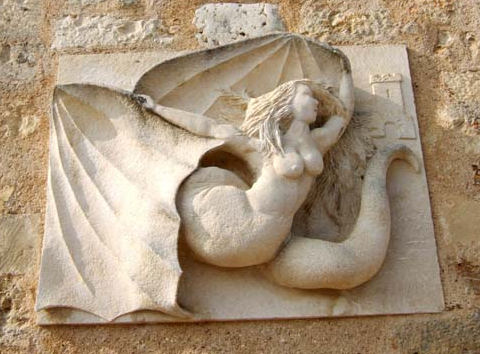 Mélusine - legend, folklore - character in the Angélique series by Anne Golon. There is much written about the Fairy Mélusine on the Internet and most of it seems to be generic and concerns three magical sisters of whom one is the eponymous Mélusine, half woman, half fish at certain times of the year. Another running theme is that of the involvement of Raymond of Poitou (or Lusignan whose castle sports a beautiful relief of this mystical creature).
Mélusine - legend, folklore - character in the Angélique series by Anne Golon. There is much written about the Fairy Mélusine on the Internet and most of it seems to be generic and concerns three magical sisters of whom one is the eponymous Mélusine, half woman, half fish at certain times of the year. Another running theme is that of the involvement of Raymond of Poitou (or Lusignan whose castle sports a beautiful relief of this mystical creature).
Just as I have written about many of the additional areas that Anne introduces into her books, on this web-site, when the 'Friends of Angélique' first saw the light of day, our resident historian Marie-France Bernier shared with us her in-depth knowledge of specific areas of the books. One of the subjects which she wrote about was the Fairy Mélusine and you can read her version reproduced here and more about the folklore of Mélusine here and what about the Hermès scarf - here.
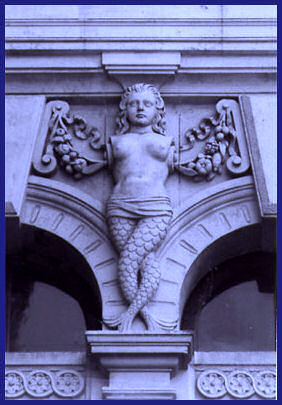
An interpretation of Mélusine at the Château de Pierrefonds (Oise)
Authoress Evelyn Waugh has used the legend of Mélusine in one of her, as yet unpublished novels, and her research is reproduced here:
The Main Legend (of Lusignan)
Once upon a time there was a beautiful fairy named Mélusine Because her father (a king of Scotland) had broken his word to her fairy mother, the mother, Mélusine, and Mélusine's two 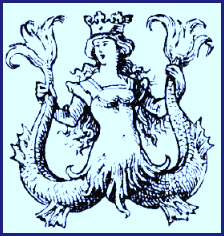 sisters were forced to leave the kingdom forever. Apparently it was a fairy thing. When Mélusine learned this story, she and her sisters locked their father up in a mountain. Her mother was so furious upon learning this that she cursed the girls.
sisters were forced to leave the kingdom forever. Apparently it was a fairy thing. When Mélusine learned this story, she and her sisters locked their father up in a mountain. Her mother was so furious upon learning this that she cursed the girls.
Mélusine's curse was that once a week, she would transform into a monster. She would grow a snake tail, and in many versions, bat wings. The only way to ease the agony of this transformation was to spend the entire day in a bathtub, keeping wet. Worse, if ever she married, and if ever her husband saw her in her monster form, she would be cursed to remain that way forever. Of course she did marry.
One day a French nobleman (in most accounts, Raymond of Poitou or of Lusignan, which is in Poitou), came across her bathing in a spring. He fell immediately in love with her, and begged her to marry him.
One of the instantly recognisable lithographs from the of legend of Mélusine
She told him she would, on one condition: He must leave her alone in her tower every Saturday night, and never,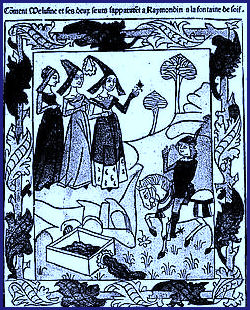 never spy on her.
never spy on her.
Raymond was so enchanted by this beautiful woman that he willingly agreed. She turned out to be a wonderful wife, too. Being magic, she could build an entire castle in a single night as she is said to have done in Lusignan, and in Vouvant, and in Parthenai. Raymond grew rich and powerful, and they had ten sons. (In some versions of the story, each of the children was in some way deformed more on that at the end).
But as will usually happen in stories like this, things turned bad. One of Raymond's jealous knights urged him to distrust Mélusine's weekly secrecy, suggesting that she was having an affair.
At his prodding, Raymond snuck into his wife's chambers as she bathed, transformed. When he saw the creature she became, he made a sound of horror, giving himself away.
A lithograph of the legend of Mélusine showing her meeting Raymond
With an unearthly scream, Mélusine flew out the tower window, cursed to remain in her monstrous form forever more.
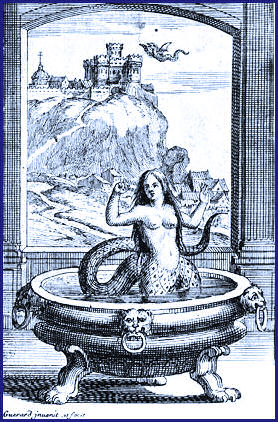
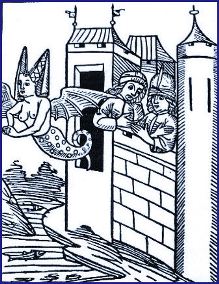
Lithographs of the legend of Mélusine showing her in the bath transforming and fleeing from Raymond and the castle of Lusignan
But this isn't the end of the story. Legend has it that ever after that moment, whenever a Lord of Lusignan her husband or son or grandson, was going to die, Mélusine would fly in circles around the tower, wailing her unearthly scream in warning, grief or both. Supposedly the banshee-like cries of Mélusine only stopped after the castle of Lusignan was torn down.
Other versions of the Legend
A common difficulty in researching medieval legends is seeing past the results of syncretism - when two or more different religious beliefs or tales fuse into one. It happened all the time. For example, scholars think the Irish warrior CuChulainn and the Arthurian knight Gawain might be different versions of the same figure because of several similarities in their legends. The tale of Mélusine is remarkably similar to that of her mother Pressine, who is also a fairy and is exiled from Scotland because her husband (who apparently came upon her bathing in a spring!) broke a taboo he'd agreed upon when they married. So are they even two separate stories, or two versions of the same?
Mélusine herself has more than one accepted legend. The second most famous to her Lusignan persona is her Angevin story. It starts the same Mélusine is bathing in the spring, and along comes a nobleman, but this time he's a Count of Anjou. And for a more Christian-morality-tale twist, she's no mere fairy. This time, Mélusine is the daughter of Satan.
This time, they only have four children and the count begins to notice something strange about his wife. Even when she attends mass, she never stays through to the end. She's always gone before the breaking of the Eucharist! Suspicious, one morning at church he steps on her cloak so that she can't leave. When the priest holds up the Eucharist, she is thus forced to look upon the body of Christ, at which point her true identity emerges you guessed it! A serpent's tail and bat wings. She flies away, taking two of her children with her but leaving two of them behind. The counts of Anjou, therefore, are said to have descended from Satan. And the Plantagenet family of England descended from the Counts of Anjou.
Other noble families have claimed descent from Mélusine, including the royal family of Luxembourg. In that version, it's Count Siegfried who marries the beautiful fairy woman, and she takes off only one night a month Wednesday nights. When she is discovered, she leaps out the window into the river.
And finally from Evelyn :
Very interesting, but Goddess ...?
In most modern versions of the story, Mélusine is a fairy. So why write about her as a goddess?
By working our way backward, chronologically. In the more modern versions of Mélusine's story there are Christian overtones since pagans don't believe in Satan (the enemy of the Christian god), then the Angevin idea of Mélusine as Satan's daughter clearly was created since France was Christianized. It is likely the detail about the "deformed" children in the Lusignan version of the legend also owes its genesis to a more modern world in which anything magic is clearly suspect. In earlier versions of the story, Mélusine's children may not have been ugly at all. Would the Counts of Lusignan have claimed such a matriarch if, during their own time, legend implied they came from deformed stock?
So we move backward to a pagan France, to a world that believed in magic without automatically condemning it, and to the word "fairy." In many contexts, fairy simply means "magic woman," as in Morgan le Fey you'll notice that in fairy tales, the good magic users are called fairies and the evil magic users are called witches. But both words mean "powerfully magic woman," and if you go far enough back in time, the stories told about powerfully magic women were being told about goddesses. "Morgan" le Fey may herself be a derivative of the powerful Irish goddess, the Morrigan.
Several other ingredients in Mélusine's story identify her as divine. The most significant of these is the idea of her turning into a part snake. Snakes are an ancient goddess symbol. One of the more famous goddess statues found in Crete is the Minoan Snake Goddess, which shows a bare-breasted woman with a snake in each hand. The Aztec goddess Coatlicue is depicted wearing a skirt of snakes. Notice that in the Garden of Eden story, it's Eve whom the serpent approaches. More about this can be found in the book "Goddess in the Grass: Serpentine Mythology and the Great Goddess" by Linda Foubister.
More information on Mélusine can be found on the following sites or by just using Google or visiting here
http://www.pantheon.org/areas/folklore/folktales/articles/melusine.html
http://legitbabenames.wordpress.com/2009/04/26/melusine/
Guest appearance of a famous person in history woven into this novel
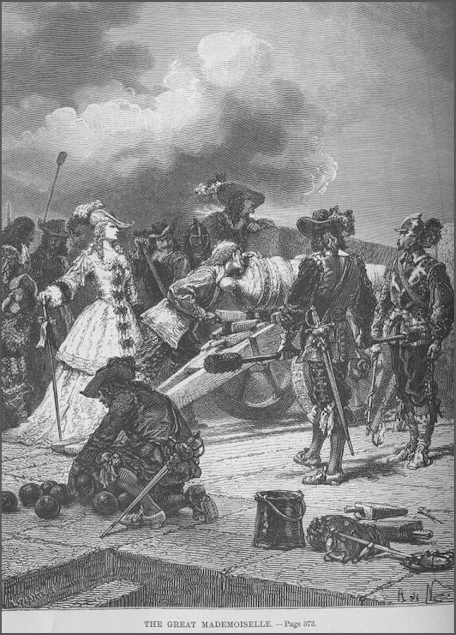
Image sourced from : ubooks.com
La Grande Mademoiselle: a rebel under Louis XIV
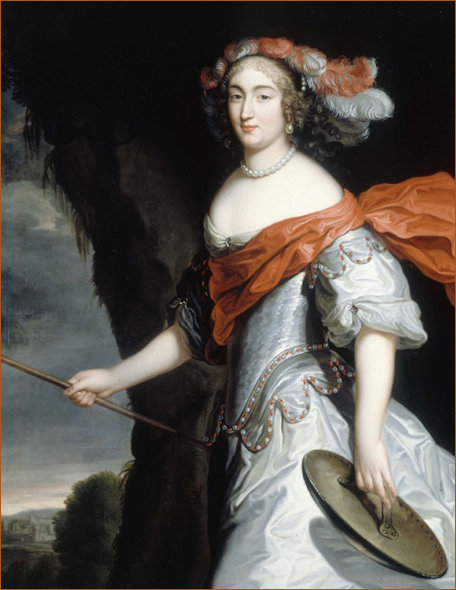
Portrait of La Grande Mademoiselle (Anne-Marie-Louise d'Orléans, Duchess of Montpensier) in Warrior Mode by Charles Beaubrun XVIIth Century (Carnavalet Museum) - sourced from Pinterest
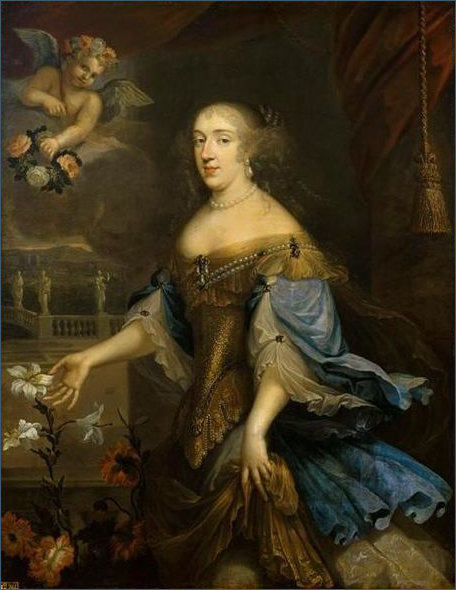
Portrait of La Grande Mademoiselle (Anne-Marie-Louise d'Orléans, Duchess of Montpensier) in more typical style confirming her royal status by the addition of a fleur-de-lys in the portraiture - "Marie-Anne-Louise d'Orléans, Mademoiselle de Montpensier dite "La Grande Mademoiselle" (1627-1693) (école de) Mignard Pierre (1612-1695) Versailles, châteaux de Versailles et de Trianon" - source : Wikipedia
As Henri IV's granddaughter, Louis XIII's niece and Louis XIV's cousin, Anne Marie Louise d'Orléans, a.k.a. La Grande Mademoiselle, allied herself with those who condemned royal power. Fearless and reckless, La Grande Mademoiselle was a carefree billionaire princess who met a tragic and romantic fate.
Anne-Marie-Louise d'Orléans, Duchess de Montpensier, who was always called "La Grande Mademoiselle", has been a figure who has fascinated French historians for centuries - unfortunately, there is little recorded information about her eventful life.
Born in 1627, Mademoiselle was the first grandchild born in the royal family of France for several centuries. She was destined to be a matrimonial pawn for her family because of her closeness to the throne and the immense fortune she inherited from her mother. She was in her time, the richest woman in France and it's greatest heiress.
It is fortunate that Mademoiselle thought to write her own memoirs during her lifetime from which we are lucky to see her life through her own eyes; from her early years and the inattention of her father, Gaston (to whom she owed her royal position) and her conflicts with the court, to her later disgrace and exile and grand love of the Sun King's courtier Lauzun. Throughout Mademoiselle's writings she concentrated on her much coveted fortune.
One earlier English work on Mademoiselle is "La Grande Mademoiselle" by Francis Steegmuller, 1956 reproduces her written "self portrait" which is reviewed as : "A touching biography of Anne Marie Louise d'Orléans, whose position at the court of Louis XIV had its historical ironies. A remarkably straightforward person at a time of petty plots and counter plots, Mademoiselle, as she was officially known, led a rich life despite frustrations. The greatest of these was the king's prohibition of marriage with her true love, a captain of the dragoons. Scholarliness and emotion as well make Steegmuller's book a valuable revelation of the period." Source : kirkusreviews
Page refreshed : 6th August 2018

